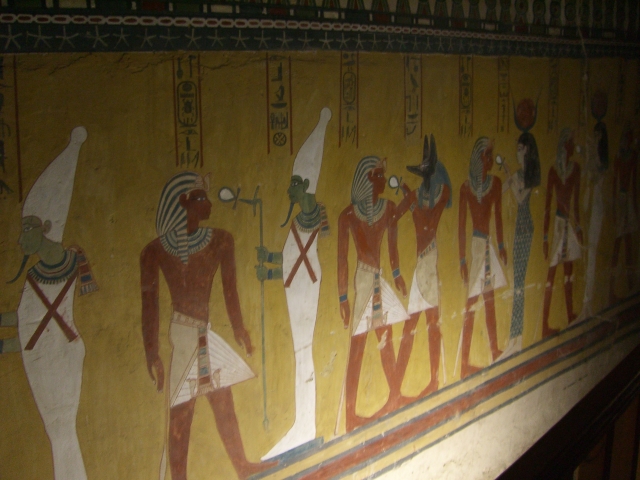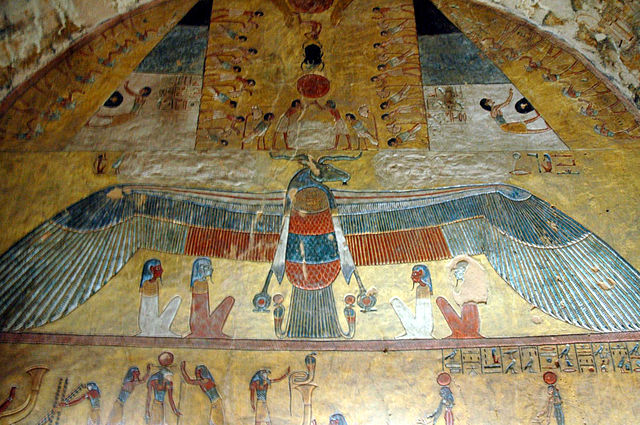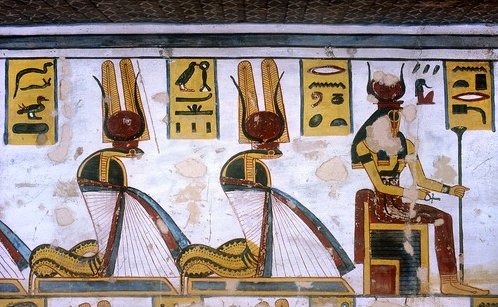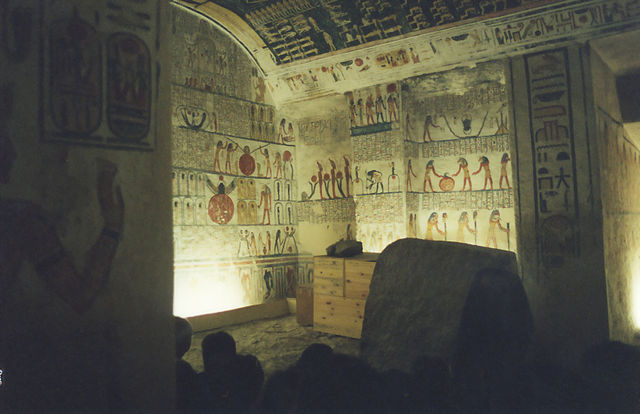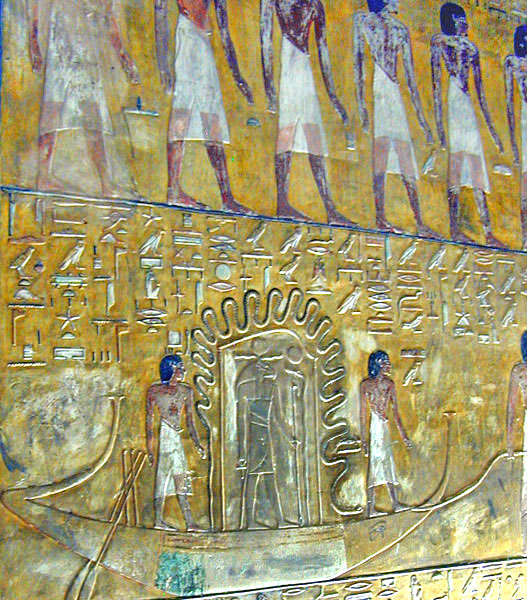Obviously you can’t spend any time on holiday in Luxor without a trip to the Valley of the Kings, and we went there on the 4th day of the Luxor part of our trip. This was one of the advertised highlights of the tour as we had special access to one of the tombs that isn’t generally open to the public (that of Seti I). We got to the valley around 6:30am and then had it pretty much to ourselves for a few hours. We had the standard “see three tombs” ticket, plus J & I bought an extra ticket to see the tomb of Ramesses V & VI. We didn’t go for Tutankhamun’s tomb as well – we’d seen it last time and didn’t think we’d have time to fit it in before going to the Seti I tomb. Originally there had been planned to be two trips to the Valley of the Kings on the holiday so we had half thought about visiting it on the second day, but plans changed and we got to go to the Valley of the Queens instead (which was cool, as I’d not been there before).
(All pictures in this post are taken from on Wikimedia Commons with licences that meant I could use them because cameras are strictly forbidden in the Valley so I have no photos of my own.)
Tutmosis IV (KV43)
The first of the tombs we went in was that of Tutmosis IV (KV43) – we picked one each from the 18th, 19th and 20th Dynasty for our set of three and visited them in chronological order. Tutmosis IV was the son of Amenhotep II and the father of Amenhotep III, and he ruled around 1400BC (roughly speaking). He is the Pharaoh who had the Dream Stela erected between the paws of the Sphinx at Giza, which says that he had a dream that if he restored that monument then he would be favoured by the gods and become Pharaoh, and lo! this is what happened. Which rather suggests that there were some irregularities in his acquisition of the throne, and it is known that he wasn’t the original Crown Prince.
My main recollection of this tomb is that it didn’t have much decoration compared to the ones we saw after it. As you walk down into the tomb at the end of the first passageway you cross a deep well (via a modern bridge) and this chamber is decorated. Then you turn left into another corridor, and just before you turn left again at the end to come out into the burial chamber there is another decorated chamber. I remember the decoration as being reminiscent in style of that in Tutankhamun’s tomb – large figures, feeling almost oversized, on a yellowy background. The plain burial chamber still has the sarcophagus at the end of it, decorated with hieroglyphs, and we spent a while with Dylan walking round it while he talked about what the various things were.
This tomb also has a later piece of hieratic graffiti in it. It had apparently been robbed and in Horemheb’s reign (last Pharaoh of Dynasty 18 or first of 19 depending how you look at it) an official had been dispatched to restore & re-seal the tomb. He (or perhaps his deputy) wrote a little note to say he’d been there and done this – Stephen Cross talked about this when he visited the Essex Egyptology Group as part of his talk on the Valley of the Kings (post).
Tutmosis IV’s mummy wasn’t discovered in his tomb – in antiquity it had been moved to KV35 (Amenhotep II’s tomb) along with several other royal mummies. It’s now in the Cairo Museum.
Tawosret and Setnakhte (KV14)
The next of the tombs we visited was KV14. Who it was dug for, and who was buried there, is a bit confusing (even the Kent Weeks book says that!) but it is from the last years of the 19th Dynasty and the beginning of the 20th Dynasty. It was probably originally dug for Seti II and his Queen Tawosret, and Seti II may well have been buried there in the first burial chamber you come to. When Seti II died his young son Siptah took the throne with Tawosret as regent, and when Siptah died young she took over and declared herself Pharaoh. The decoration in KV14 was partially altered for Siptah but he was then buried in KV47 and Tawosret started to alter the decoration again for herself. However she didn’t last long on the throne and was overthrown by Sethnakhte. He intended himself to be buried in KV11 (see below) but when his son Ramesses III came to the throne he had his father interred in KV14. So the decoration once again began to be altered (particularly removing Tawosret). However given the rapid turnover of intended occupant most of the decoration is that which was designed for Tawosret as either Queen or Pharaoh (where she ended up buried is unknown, perhaps KV13). Kent Weeks labels the second burial chamber on his plan of the tomb as “Burial Chamber of Tawosret with Sethnakhte’s Sarcophagus” which seems to sum up this confused tomb!
This tomb was much more fully decorated than Tutmosis IV’s tomb, and the style more reminiscent of the tombs we’d seen last time we visited the Valley of the Kings. I’m not sure if this is a pre-/post-Amarna period shift, but that would seem plausible. And now is when anyone reading who is particularly into Egyptian tombs wishes it wasn’t me writing this … 😉 I was mostly looking at the recurring motifs in the decoration, and appreciating their aesthetic qualities rather than looking at the meaning & symbolism of the composition as a whole. So from this tomb onwards a lot of what I was looking at was snakes – snakes with legs, snakes with heads, snakes as walls (particularly protecting gods or the deceased), snakes as paths, snakes as transport. Snakes everywhere, once you got your eye in. Sadly none of the photos I found to use for this tomb had particularly prominent snakes in them.
Ramesses III (KV11)
For the third tomb on our ticket we chose the properly 20th Dynasty tomb of Ramesses III (KV11). Ramesses III was the son of Sethnakhte and can be seen as the last great Egyptian Pharaoh. He had a long but somewhat turbulent reign – he is the Pharaoh who fought off the Sea Peoples amongst other invaders. And internal politics must also have been full of conflict as he was (probably) eventually assassinated by a harem conspiracy led by one of his wives (Tiye) and one of his sons (Pentaweret).
As I mentioned above this tomb was started by Sethnakhte but Ramesses III took it over. As you go down the initial corridor after a while you suddenly come to an undecorated wall with a little label saying Amenmeses. And then you have to turn right then immediately left in order to follow the corridor further into the tomb. When it was being built for Sethnakhte the workmen misjudged where to put the tomb, and broke through into KV10 (the tomb of Amenmeses, a 19th Dynasty Pharaoh). This may be why work stopped and there was a long gap between Sethnakhte being buried in KV14 and Ramesses III restarting work on KV11. We had organised our viewings of the tombs perfectly – the quality of the decoration in this tomb is a step up from that in KV14 which had been a step up from KV43. I was again mostly looking out for snakes in all their many roles. This time I’ve found a photo to use that has some – the three (one with human body) here are the deities Nepret, Renenutet and Hu.
Ramesses V & Ramesses VI (KV9)
KV9 is one of the tombs in the Valley for which you have to purchase an extra ticket – we did that this time as we’d seen Tutankhamun’s tomb last time we visited. This tomb was started by Ramesses V and completed by Ramesses VI, and both Pharaohs were buried here. The reigns of these sons and grandsons of Ramesses III were all pretty short, and the direct line of succession kept dying out – the succession goes: Ramesses IV (son), Ramesses V (grandson), Ramesses VI (son), Ramesses VII (grandson), Ramesses VIII (son) and then Ramesses IX whose relationship to the others is obscure but possibly a grandson (according to Aidan Dodson & Dyan Hilton’s book “The Complete Royal Families of Ancient Egypt). This is one of the reasons Ramesses III can be considered the last great Egyptian Pharaoh as I mentioned above. The tomb was robbed in antiquity, and the bodies of both Pharaohs were moved to the cache of royal mummies in KV35 shortly afterwards.
The decoration in this tomb was another step up in quality and the tomb itself felt more spacious. Kent Weeks devotes about 30 pages of his Luxor guidebook to describing the scenes in this tomb, and I wish we’d owned the book before we visited as I might’ve had a much better idea of what I was looking at if I’d read it first! The reason he discusses it so thoroughly is that it contains more complete versions of several of the texts than are usually found. Again I was mostly looking for the snake motifs I’d been looking at in the other tombs. I also particularly noted the ceiling in the burial chamber, which was pretty spectacular. It is painted in blue with gold figures & hieroglpyhs showing the Goddess Nut and two of the astronomical texts depicting the passage of the sun god through the day and the night.
Seti I (KV17)
We broke with chronological order here to go to the featured highlight of the visit to the Valley – KV17, the tomb of Seti I. Seti was either the second or third Pharaoh of the 19th Dynasty (depending on how one counts Horemheb), and the son of Ramesses I and father of Ramesses II. One of the threads running through our holiday was Seti I – we had seen the man himself in the Cairo Museum, his temple at Abydos, now his tomb and would soon see his mortuary temple. He was also a shadowy presence whenever we saw anything relating to Ramesses II, as Medhat would compare the art styles of father and son (with son always coming up as lacking his father’s taste & refinement).
This tomb was again a step up in quality of the decoration – as you would expect from Seti I. It’s been damaged significantly since its original discovery in 1817 – in part by archaeologists of the time making “squeezes” (where you put wet paper on the wall then let it dry to copy the design), in part by archaeologists removing chunks of wall for museums, and in part because of flooding (made worse by removal of natural barriers at the tomb entrance preventing the water from entering the tomb). However the damage isn’t really what one notices when actually there – yes, it’s obvious, but you can still get an idea of how it used to be. We had a limited time in this tomb, so I started by making my way to the bottom fairly briskly then working my way back up. Again I was mostly looking for snake motifs, but I did note some other things. In the last of the decorated chambers you can get to there was a rather odd feature running right round the wall that looked almost like it was supporting a ceiling halfway up the room. It was even decorated with the sorts of motifs you find round the coving in Egyptian rooms. One of the rooms further up was unfinished, which is always fascinating – you get to see how the designs were created. And of course there were snake motifs too, the one that particularly caught my eye (that I hadn’t seen in the other tombs) was a long snake running across the whole of one wall of a room plus bits on the adjoining two walls. It had 12 mummies laid out on it, evenly spaced. Each mummy had 2 pairs of legs associated with it, descending from the snake – so it was like twelve mummification beds in a row.
